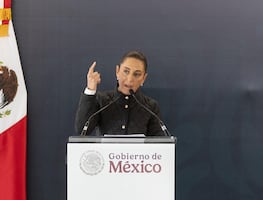Más Información

“Vamos a dar apoyo a los pequeños agricultores por sequía en Sonora”; Claudia Sheinbaum instruye a Berdegué

Derrota de México en disputa por maíz transgénico contra EU; estos son los argumentos de Sheinbaum y AMLO para prohibirlo

Óscar Rentería Schazarino, ha operado contra CJNG, Viagras y Templarios; es el nuevo secretario de Seguridad en Sinaloa

Claudia Sheinbaum pide respeto para Maru Campos; gobernadora anuncia acuerdo para transporte público

Claudia Sheinbaum anuncia los Centros de Cuidado Infantil en Chihuahua; inaugura hospital en Ciudad Juárez
Mexico’s Navy
struck a blow against the Jalisco New Generation cartel (CJNG) with the arrest of Ismael Gómez Sierra, “El Chiquilín,” and Flavio Roberto Ortiz Muñox, “Basuras,” two of its main operators in Baja California.
Along with the State Group of Investigation Security (GESI) in Baja California, naval personnel was able to capture on Tuesday “El Chiquilín” at Ensenada, as informed by federal sources.
They seized two handguns and drugs which were made available to Mexico’s Attorney general’s Office (FGR).
Yesterday, naval personnel arrested Flavio Roberto Ortiz Muñox, “Basuras,” the alleged CJNG hitmen chief in Tecate.
According to federal sources, a joint operation between the Navy and the GESI was able to locate Ortiz Muñoz, considered the main target for the Baja California government at the Tecate municipality.
Recommended:
Authorities hold him accountable for the escalating violent homicides in the municipality.
According to ministry investigations, Flavio Roberto Ortiz Muñox, “Basuras,” has a criminal record over the possession of firearms of exclusive use of the military, injuries, car theft, and murder.
Likewise, he has a valid arrest warrant for the crime of attempted murder, with the aggravating circumstance of advantage, according to the penal cause 00234/2019, issued by a judge in criminal matters.
Ortiz Muñoz was born in Tecate and during his youth, he spent time with whom would become his boss, Dany Isac Ortiz Covarrubias, best known as “Moreno,” and first became part of the Sinaloa Cartel as drug dealers to continue ascending in the criminal organization until becoming hitmen.
It is known that during the first CJNG raids in 2015 in the municipality, several members of the Sinaloa cartel changed sides to strengthen the new criminal group. That was how Ortiz Muñoz was in charge of creating the hitmen cell that collects extortions and protection from merchants and businesses as the so-called magical town.
It was until 2017, after the death and arrest of some of the CJNG leaders in Baja California that Ortiz Muñoz gained relevance by leading five hitmen cells comprised of at least 20 people who kept an iron grip of their territory by preventing other enemy cells from operating in the area.
Recommended:
Jalisco Nueva Generación Cartel
The Jalisco Nueva Generación Cartel (CJNG), is based in Guadalajara, Jalisco. It distributes drugs in Los Angeles, New York, Chicago, and Atlanta. Furthermore, this drug trafficking organization is “one of the most powerful and fastest-growing cartels in Mexico and the United States” as it has a presence in at least 24 of 32 Mexican states.
This drug cartel is characterized by its rapid expansion and its willingness to “engage in violent confrontations with Mexican Government security forces and rival cartels.”
It was originally known as the Zeta Killers, the CJNG made its first appearance in 2011 with a roadside display of the bodies of 35 alleged members of Los Zetas.
The CJNG has early roots in the Milenio cartel, which was active in the Tierra Caliente region of southern Mexico before it disintegrated in 2009. The group is a by-product of the Milenio cartel’s collapse and was allied with the Sinaloa federation until 2014.
Cartel Jalisco-New Generation reportedly served as an enforcement group for the Sinaloa Cartel until summer 2013. Analysts and Mexican authorities have suggested the split between Sinaloa and CJNG is one of the many indications of a general fragmentation of crime groups. Ruben Oseguera Cervantes, alias “El Mencho,” a top wanted fugitive by the DEA, is the group’s current leader.
In 2015, the Mexican government declared CJNG one of the most dangerous cartels in the country and one of two with the most extensive reach. In October 2016, the U.S. Department of the Treasury echoed the Mexican government when it described the group as one of the world’s “most prolific and violent drug trafficking organizations.”
According to some analysts, CJNG has operations throughout the Americas, Asia, and Europe. The group allegedly is responsible for distributing cocaine and methamphetamine along “10,000 kilometers of the Pacific coast in a route that extends from the Southern Cone to the border of the United States and Canada.”
mp





